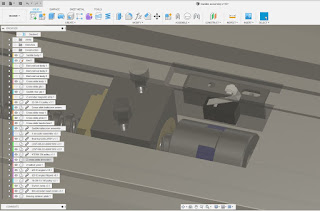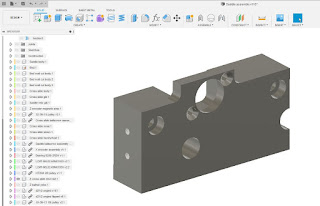Enough of the virtual stuff. Time to cut some metal.
Apart from the trusty old 50mm face mill, these are the tools required to make the bracket.
Manually machine up the stock to exact length (139mm). Those 10mm end mills are razor sharp still, generating bum fluff swarf.
One of The Annoying Changes that Autodesk have made to the free version is preventing tool changes between operations within the same file. No problem - I usually generate a separate file for each tool anyway and the Fusion file is open on the same PC as it is, so I can quickly generate the g-code, save it directly to the Acorn directory and load it from there.
As for the removal of rapids, it's not a big deal when you only have a few operations on a (physically) small part, so no big irritation there.
Let's go!
No pics but here's the first operation done - drill and bore holes and channel.
Flip over and pick up the datum origin from the centre of the bored hole.
What could possibly go wrong etc...
Nothing so far!
That's the main milling work completed
The chamfer mill has to sneak down to the features within the cavity. IIRC, the clearance is a nominal 0.25mm.
That's the "inner" side operations complete. That left the "outer" features to be completed, namely facing off the remaining stock, counterboring the fixing holes and chamfering the edges.
Z bracket - done:
A couple of annoyances:
As you can see, the simulated final component has a couple of ridges either side of the cavity - that's visible in the pics if you look closely. The Stupid Fat Bloke was put in charge of generating the toolpaths here and years of self abuse and generally sloppy attention to detail allowed this to remain overlooked right to the end. Furthermore, even a half arsed inspection of the component before removing it from the vise would have allowed a followup operation to remove it. It wouldn't be a massive challenge to go back and do it even now but I refuse to be that anal. It's a non-functional, cosmetic flaw that can remain as a reminder of what a shit job I can put out if needs be.
Also, there seems to be a slight error in the longitudinal origin (whether it was X or Y depends on which setup we are talking). Although all the features within that setup were coordinated, they ended up misaligned to the previous ops by perhaps as much as 0.5mm. The result was the vertical edges at each end were either overchamfered or almost not at all. Only affected 2 edges but it's still f annoying.
But does it fit?
Well yes, at least that bit worked out OK. I haven't checked the alignment of the ballscrew with the bearing but unless I really screwed up the dimensions, there should be enough slop in the fixings to accommodate some tolerance on those - which is why I took that approach. Lessons were learned from the Bridgeport Z axis!
And yes, the bearing is a decent fit in its bore.
Next?
It may be time to start butchering the cross slide body next...













































